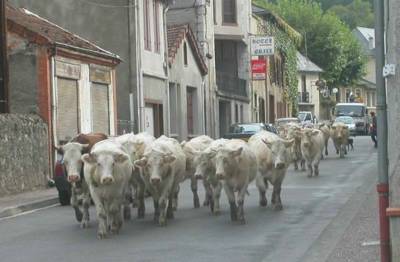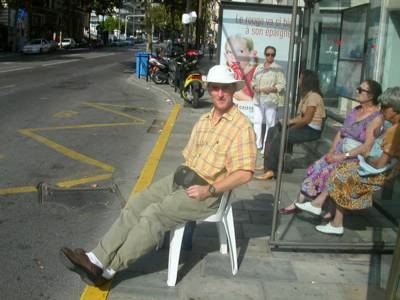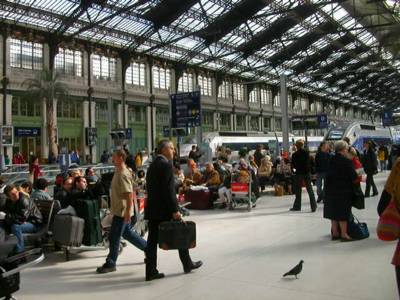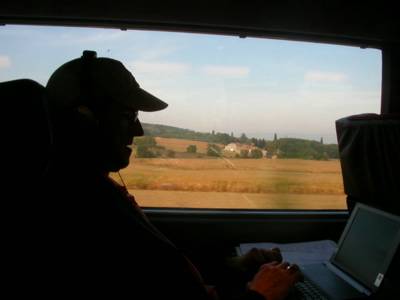
View from the visitor's entrance at the cave at Niaux, south of Foix in the French Pyrenees, showing metal sculpture and overlook platform to the right.
Saturday, October 09, 2004
When I first began work on a review of Clayton Eshleman’s Juniper Fuse in July, I imagined yesterday’s moment: my own view of Upper Paleolithic images drawn on a cave wall in France. I did not imagine how distracting the realities of a cave tour would be. Darlene and Deb and I were part of a group of 13 guided into the cave by a young woman whose English was pretty good, but due to a mix-up this was not to be the English tour I had reserved a month ago. We made our way across uneven rocky floor for about 45 minutes until we reached the images, surprisingly realistic drawings of bison, horses, ibex, and ancient oxen. There they were, the work of artists between 10,500 and 11,500 years ago. If I’d hoped for a shaman’s insight into art or life, I missed it. The guide was talking, shining her red-dot pointer on the images, and I was trying to translate snatches of her talk to Deb and Darlene. The moment I remember most is when we stood beneath a high dome and we all turned off our lamps. Before the guide spoke and then raised her voice to make eerie echoes, I stood in a moment of complete darkness and silence. Somehow, out of that place, deep underground, humans began making art more than 200 generations ago. That turned out to be the moment I will remember with much gratitude.

Afternoon traffic on the main street through Castillons-en-Couserans today.
Friday, October 08, 2004
The night train to Toulouse could have been a time capsule, for our sense tonight of having been transported back centuries in time. Not that the city of Toulouse lacks modern conveniences, including an Avis rental car office at the train station, ATM machines, and an autoroute throbbing with commuter traffic this morning as we made our way an hour and a half southward. But by the time we reached the hillside hamlet of Selsein and asked enough neighbors for directions to find the unmarked home of Judith Matulova, we could have been in the 1500s, which is when the house was built. After late-morning naps to catch up on sleep, we walked three kilometers down the one-lane road from Salsein to Castillons. I bought a walking stick, which prompted a smiling guy with a pencil moustache to ask me in French, “Where are your cows?” We toured a cheese museum and bought some of the local brand, Bamalou. And then, by God, here came the cows, right down the middle of Castillons, trailed by two men on foot and a dog. Later, from our window in Grande Ourse, Darlene and I watched a shepherd and two dogs work a flock of sheep down a nearby hillside. She and Deb had a chance before we left for supper to see brand new lambs in a barn a few steps up the road from the B&B. It is silent here, except for a village church bell tolling the hour. The beams in our room are more than 400 years old. Selsein is a good launching pad for tomorrow’s trip even further back in time, to more than 10,000 years ago when the first artists painted images on the cave walls at Niaux.

Len waiting in his own chair at the Place Vauban bus stop on Boulevard Carnot.
Thursday, October 07, 2004
The driver of the 3VB to Mougins gave me an odd look when I climbed aboard with a white pool chair that Andre and Jacqueline had loaned me. I have used the loaner to avoid wear and tear on the antique chair at the desk in Francoise’s room, but today it was time to return the pool chair. I took the bus to Mougins, dropped off the chair and took the blue Honda to a carwash. I also filled it with regular unleaded gasoline, which costs an impressive $4.20 a gallon in a country serious about energy conservation.
Right now we are packing for the night train to Toulouse, which will leave Cannes at 10:32 pm and arrive tomorrow at 5:08 am. I booked three couchettes, which may or may not mean a few hours of sleep, because I have no idea what a couchette is. From Toulouse, we will strike out tomorrow in a rental car toward a long-planned rendezvous with Upper Paleolithic art in a cave at Niaux. I’m not sure if Maison de la Grande Ourse, our scheduled three-room bed and breakfast in Salsein, will have a phone line suitable for internet connection, so the Chronicles may go dark until our return Sunday night.
Right now we are packing for the night train to Toulouse, which will leave Cannes at 10:32 pm and arrive tomorrow at 5:08 am. I booked three couchettes, which may or may not mean a few hours of sleep, because I have no idea what a couchette is. From Toulouse, we will strike out tomorrow in a rental car toward a long-planned rendezvous with Upper Paleolithic art in a cave at Niaux. I’m not sure if Maison de la Grande Ourse, our scheduled three-room bed and breakfast in Salsein, will have a phone line suitable for internet connection, so the Chronicles may go dark until our return Sunday night.

Gare du Lyon in Paris, with two of the bullet-shaped TGV engines in background.
Wednesday, October 06, 2004
Aboard the Train a Grand Vitesse (TGV), Paris to Cannes
This train is bound for glory, Spencer Bohren sings in my headphones as I begin today’s Chronicles. So I’ll go with that. Deb is working on crochet, Darlene is reading a mystery. This train is built for speed, it’s the fastest train that you ever did see...whooh-whooh. We zoom past thirsty-looking low trees and distant, misted mountains in our speed-bubble, returning home to Cannes with sore feet. This train don’t carry no gamblers, no hypocrites, no midnight ramblers, this train is bound for glory… Last night I talked Darlene into taking a late boat ride on the Seine. We had one of the long Bateaux Mouches nearly to ourselves and didn’t get back to the hotel until midnight. The Eiffel Tower, its girders lit so they looked like lace, seemed an even more preposterous but exactly right creation than it appears during the day. It’s no wonder that on Monday we saw soldiers prowling beneath it with their fingers on the triggers of machine guns, looking for anyone who might be tempted to topple the one building in the world that most perfectly says, “Paris.” Long may it stand, along with the artistic types, my people, who first greeted it with such horror that they staged protest lunches in the tower’s Jules Verne Restaurant, the only place in Paris where they didn’t have to look at the damn thing. The builders of towers and the mockers, the artists and the politicians, the sleepers and the midnight boat riders: in my smooth train vibe, we’re all on the TGV today, bound for glory--or at least for Cannes.
This train is bound for glory, Spencer Bohren sings in my headphones as I begin today’s Chronicles. So I’ll go with that. Deb is working on crochet, Darlene is reading a mystery. This train is built for speed, it’s the fastest train that you ever did see...whooh-whooh. We zoom past thirsty-looking low trees and distant, misted mountains in our speed-bubble, returning home to Cannes with sore feet. This train don’t carry no gamblers, no hypocrites, no midnight ramblers, this train is bound for glory… Last night I talked Darlene into taking a late boat ride on the Seine. We had one of the long Bateaux Mouches nearly to ourselves and didn’t get back to the hotel until midnight. The Eiffel Tower, its girders lit so they looked like lace, seemed an even more preposterous but exactly right creation than it appears during the day. It’s no wonder that on Monday we saw soldiers prowling beneath it with their fingers on the triggers of machine guns, looking for anyone who might be tempted to topple the one building in the world that most perfectly says, “Paris.” Long may it stand, along with the artistic types, my people, who first greeted it with such horror that they staged protest lunches in the tower’s Jules Verne Restaurant, the only place in Paris where they didn’t have to look at the damn thing. The builders of towers and the mockers, the artists and the politicians, the sleepers and the midnight boat riders: in my smooth train vibe, we’re all on the TGV today, bound for glory--or at least for Cannes.
As I approached the palace at Versailles this morning, an entire parking lot of tour buses announced what I would find: endless crowds. Yesterday I’d arrived at the Musee Picasso a half hour after it closed, and the Segway tour had given me a belly full of magnificent monuments. Darlene is carrying around the Michelin Green Guide to Paris as if it’s the New Testament, but her authentic delight at seeing every single sight she can cram into a day and part of a night is, I’m afraid, not catching. She knows the signs and suggested I go amuse myself today while she and Deb looked for fabric. So I hopped a train at Gare Montparnasse for the 20-minute ride to Versailles, figuring I would simply land in a coffee shop and write, without ever going near the palace, as a sort of passive-aggressive guerilla attack on the tourism industry. I did find a good spot, at the Ibis Hotel across from the ornate City Hall. But in the end, I was drawn irresistibly up the hill. I bought a ticket to the gardens. I began taking photos of tourists taking photos of each other. The crowds gave me perfect cover, because everyone was aiming a camera at someone or something. The scale of the palace and gardens is beyond comprehension, so it’s no wonder the crowds are so big. True grandeur is irresistible. And by the time serious rain cut short my visit, I had begun to enjoy the bustle of the schoolchildren, the couples taking each other’s photos, the painterly patterns of the umbrellas. I bought a hot dog on the return to the train station and read today’s International Herald Tribune on the ride back to Montparnasse, thinking, “Mission accomplished.”
Darlene and Deb, meanwhile, found the mother lode of fabric shops at Marche St-Pierre in the 18th Arrondissement, on a tip from Joyce Heard. At one spot, a crowd of women had gathered, large enough that it looked as if they were waiting to go into a movie. Darlene asked someone across the street what was up and found out it was a fabric shop known for its reasonable prices, and that it was having a big sale, on all four floors. A bin full of scarves had bargains too good to pass up. Deb found a fabric that looked and felt like paper, and she bought a good supply of it at another store, that turned out to be one of the oldest in the district. They also bought bright-colored buttons, about the size of quarters, made from shells.
Darlene and Deb, meanwhile, found the mother lode of fabric shops at Marche St-Pierre in the 18th Arrondissement, on a tip from Joyce Heard. At one spot, a crowd of women had gathered, large enough that it looked as if they were waiting to go into a movie. Darlene asked someone across the street what was up and found out it was a fabric shop known for its reasonable prices, and that it was having a big sale, on all four floors. A bin full of scarves had bargains too good to pass up. Deb found a fabric that looked and felt like paper, and she bought a good supply of it at another store, that turned out to be one of the oldest in the district. They also bought bright-colored buttons, about the size of quarters, made from shells.

Near the start of our Segway tour of Paris today, we posed on the Human Transporters in front of a landmark where, on average, 152 wedding proposals are made daily.
Monday, October 04, 2004
Hotel Apollon Montparnasse, Paris
Segway City Tours has perfected the training of Segway novices, and within an hour Deb, Darlene and I were gliding along with a trio of Texan women. As you can imagine, a Segway tour of Paris is more about Segways than about Paris. Our guide, who rode a bicycle, herding us like six odd ducklings, is a studio arts graduate of Southern Methodist University, also in Texas. In front of Napoleon’s tomb, she informed us that just before the French Revolution, “the peasants were spending 80 percent of their money on bread, and the royalty were just drizzling gold everywhere.” Everywhere included the dome of the structure Louis XIV built for his family’s graves, but instead Napoleon is buried there, arranged so that anyone looking at him has to bow. Anyway, Daniele did a good job of keeping everyone safe. She kept her cool when two of the three Texans stumbled off their units, without injury. Deb, a first-time Segway rider, was a natural, as was Darlene, who has some prior experience. Six Segways rolling along single file through Paris is a sight that prompted many video cameras to spring into action. I did a lot of waving to Japanese tourists, who waved back and kept their cameras rolling.
Segway City Tours has perfected the training of Segway novices, and within an hour Deb, Darlene and I were gliding along with a trio of Texan women. As you can imagine, a Segway tour of Paris is more about Segways than about Paris. Our guide, who rode a bicycle, herding us like six odd ducklings, is a studio arts graduate of Southern Methodist University, also in Texas. In front of Napoleon’s tomb, she informed us that just before the French Revolution, “the peasants were spending 80 percent of their money on bread, and the royalty were just drizzling gold everywhere.” Everywhere included the dome of the structure Louis XIV built for his family’s graves, but instead Napoleon is buried there, arranged so that anyone looking at him has to bow. Anyway, Daniele did a good job of keeping everyone safe. She kept her cool when two of the three Texans stumbled off their units, without injury. Deb, a first-time Segway rider, was a natural, as was Darlene, who has some prior experience. Six Segways rolling along single file through Paris is a sight that prompted many video cameras to spring into action. I did a lot of waving to Japanese tourists, who waved back and kept their cameras rolling.


